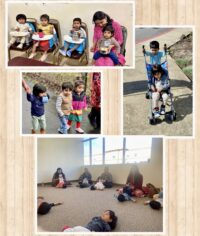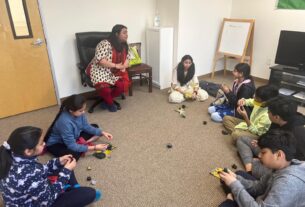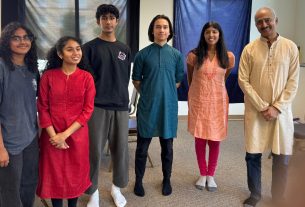We had the privilege of teaching Bhagavad Gita chapters 1, 2, 14, and 17 to the 9th graders. We started the academic year by reviewing the Mahabharata in detail and then starting the first chapter of the Bhagavad Gita. After covering Arjuna Vishada Yoga (Yoga of Arjuna’s sorrow), we spent a lot of time covering Sankhya Yoga, chapter 2. During this time, we also covered the various aspects of the BMI chart, the difference between the small ‘i’ (BMI and ego) and the big ‘I’ (consciousness), the four types of purusharthas (dharma, artha, kama, moksha), the ladder of fall, and various aspects of dharma. When we covered the qualities of a self-realized being, the students asked who could be one example of such a being. It helped that we have Gurudev’s pictures in all our classrooms and we were able to point to him. Chapter 2 helped students deeply appreciate the significance of a guru and the greatness of a self-realized being.
Because high school tends to be stressful for students, we decided to cover chapter 14, Guna-traya Vibhaga Yoga, which deals with mind management. We hoped that this knowledge would be helpful to high school students in their pursuit of higher aspirations and also help them learn how to be calm. We covered the three qualities the mind can take – sattva, rajas, and tamas – and how the moods of the mind can create bondage. The students learned that the way to master the mind is through knowing the mind, tuning the mind, and transcending the mind. Next, we covered Shraddha Traya Vibhaga Yoga, chapter 17. The students learned about the three types of faith (sattvic, rajasic, and tamasic), and how such faith influences everything we do in terms of what we eat, whom we worship, how we worship, and how we perform austerities.
We had students take systematic notes, and we believe that helped them reflect on the material we covered in previous classes. We also used some props to illustrate certain concepts (e.g., we used a cup and water to illustrate the idea of Jiva’s rebirth). We consistently used a meditation exercise to help students center themselves on the Self. We called this exercise Being Aware of Being Aware (credit to Rupert Spira for coining this term). This exercise involved students watching their thoughts, feelings, and sensations without identifying with them, and asking to whom such thoughts, feelings, and sensations occurred. Once they got an intuition of the ‘Knower’ in them, they practiced staying with it.
Overall, we had a curious group of students who actively participated in every session. They engaged with the teachers very well and were also quite happy to interact with each other. For the annual day, we asked them to prepare an essay to summarize their learning, and they did a brilliant job with it. We just had to edit a few things, but we marveled at their ability to quickly grasp concepts. No wonder it’s the Grace of Gurudev that makes all this possible.
Om Sri Gurbhyo Namah!



